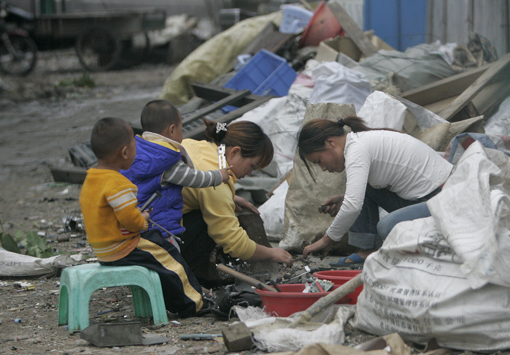The world’s plastic crisis is only growing worse: Plastic production continues to expand and single-use plastic has skyrocketed, thanks to COVID — and frankly, waste management cannot keep up.
To make matters more challenging, there is no silver bullet to the plastic crisis. Our society requires plastic to function, but its consumption and disposal need to change drastically. As trillions of microplastics circulate our oceans and plastics choke our environment, accelerating system change is essential and imminently required.
Aggravating the issue is the complexity of tackling the severe environmental and human costs. Currently, the ethical disposal and management of waste are starkly underfunded. In the next 20 years, we need $600 billion to bridge the evident funding gap in our system and turn this crisis around.
However, there is a silver lining: If we enable systemic solutions now, we may still turn the clock in our favour. The question to ask is, what is being done?
Our society needs to empower innovations that can tackle plastic waste and spur the adoption of circular economy models. One such tool up for the task is plastic credits. In a nutshell, purchasing a single plastic credit enables a kg of plastic waste to be diverted from nature.
The adoption of plastic credits is relatively novel, and the plastic credit market is still taking shape. Corporate dollars constitute the accelerating force behind the flow of funding to plastic-waste management initiatives.
Investing in impactful plastic action
As the plastic credit market continues to gain ground, the need for standardization has been a priority. The resulting Plastic Waste Reduction Standard, headed by Verra, has evolved from months of toiling over drafts and countless consultations. The coalition of leaders contributing to its development includes major bodies such as BVRio and the 3R Initiative; brands including Danone, Veolia and Tetra Pak; and impact platforms such as rePurpose Global.
The plastic credit market’s standardization defines a roadmap for plastic reduction, recovery and recycling through a transparent and verifiable impact process. The Plastic Waste Reduction Standard provides clear methodologies for generating plastic credits and comprehensive guidelines for corporate plastic stewardship. Under this framework, brands can take action combatting their plastic footprint, by purchasing rigorously assessed and verified plastic credits.
A critical foundation for the assessment process and the plastic credit market is the concept of additionality: Each plastic credit must account for one additional kg of plastic waste otherwise bound for nature. An example explaining additionality is the recovery of non-recyclable, multi-layered plastic waste — specifically, when the recovery occurs in a geography such as rural India, where such materials have no after-market value. Thanks to plastic credit financing, the collection, processing and end-use of the neglected plastic waste can be ensured.
The plastic credit market is creating an opportunity for brands to seize the moment, convert their reduction claim into action, and answer the call of their customers and stakeholders. In fact, 88 percent of consumers want brands to make a positive impact. Brands such as Grove Collaborative and The Hut Group have taken the initiative and used plastic credits to amplify their existing sustainability strategies. Both brands have set a precedent by becoming certified Plastic Neutral by financing the removal of as much nature-bound plastic waste as their supply chain creates.
As the call for environmental action grows louder, corporate stewardship is the need of the hour. While the journey may seem daunting, taking plastic-waste reduction actions — including becoming certified Plastic Neutral — is attainable for brands of any size, anywhere in the world.
A brand’s guide to the plastic credit market
Conscious action is the climate economy’s new currency. Individuals and brands recognize the need to reduce their plastic footprint; however, plastic alternatives may cause even more environmental harm. Welcome to the plastic credit market.
Plastic credits are poised to generate the momentum necessary to launch a circular plastic economy and give brands the opportunity to act. In order for brands to take action, they will need to follow these four priorities:
1. Measuring plastic footprint
The first step of taking action is to calculate a brand’s plastic footprint through a specialist organization. Much like one’s carbon footprint, each brand will need to measure the quantity and polymer of plastics being used in their supply chain, packaging and products. Primarily, a plastic waste audit can help illuminate where and how your brand can internally reduce its plastic footprint and set targets for the future. Additionally, understanding quantity and quality will set the stage for the purchase of plastic credits to take immediate action against your remaining plastic footprint.
2. Financing plastic action
Plastic credits play a dual role in the battle against plastic pollution. On the one hand, they finance plastic-waste removal projects. These projects often focus their recovery on geographies devastated by plastic waste, lacking formalized recycling, or inundated with marine plastic pollution.
On the other hand, plastic credit funding enables brands to support plastic action beyond their own footprint — by accelerating the avoidance, reduction and redesign of plastic out of the system entirely. These plastic credit financing projects are usually platform-specific; but a great example is the rePurpose Global’s collaboration with Saathi Pads — an India-based manufacturer of plastic-free, biodegradable sanitary pads. Through plastic credit financing, they are able to subsidize the cost of distributing Saathi Pads to marginalized community members in Gujarat, India — avoiding single-use plastic-containing menstrual pads entirely.
3. Setting meaningful reduction targets
Reduction targets frequent the environmental newsfeeds; but they’re often vague, with loose timelines. Setting actionable, internal plastic-waste reduction targets and milestones is key to every credible reduction strategy. Each goal should be specific and encompass six characteristics: informed, measurable, precise, ambitious, comprehensive and timely. Committing to these claims will help define each brand’s corporate stewardship and set an industry precedent.









